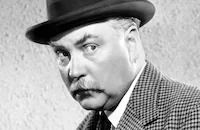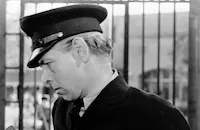The Scarlet Claw
Brief Synopsis
Cast & Crew
Roy William Neill
Basil Rathbone
Nigel Bruce
Gerald Hamer
Paul Cavanagh
Arthur Hohl
Film Details
Technical Specs

Synopsis
The townspeople of the small village of La Morte Rouge, just outside of Quebec, Canada, live in fear, as a glowing, murderous phantom has been stalking the nearby marshes. When Father Pierre goes to investigate the late-night ringing of his church's bells, he finds the murdered body of Lady Lillian Penrose clutching the bell rope. Meanwhile, Lord William Penrose is in Quebec, addressing a meeting of the Royal Canadian Occult Society about the history of the phantom. Also at the meeting are the famous English private detective Sherlock Holmes and his trusted companion, Dr. John H. Watson. After learning of Lady Penrose's death, Holmes receives a letter she had earlier sent to him, asking for his protection, so he and Watson decide to go to La Morte Rogue and investigate her murder. Holmes soon discovers that Lady Penrose was Lillian Gentry, a popular English actress who disappeared years earlier. He then questions innkeeper Emile Journet, an ex-prison guard who moved to La Morte Rogue around the time of the phantom's reappearance. That night, Holmes investigates the marsh lands where the glowing phantom has been sighted, and after encountering the "monster," Holmes finds a piece of a torn cotton shirt soaked in phosphorescent paint. Later, Holmes learns that the expensive shirt had been purchased by a retired, wheelchair-bound magistrate, Judge Brisson. While visiting the judge at his home, Holmes uncovers that Brisson is not disabled, but merely fears for his life. Brisson tells the detective that he had ordered Nora, his housekeeper, to give some of his old shirts to a boatman. Along with police sergeant Thompson, Holmes and Watson find the boatman, Jack Tanner, but he escapes their clutches by jumping out a nearby window. Holmes then learns that Lady Penrose had retired from the stage after witnessing fellow actor Alastair Ramson kill another member of their stage company. Lord Penrose tells Holmes that Ramson was believed killed in a prison break, and Holmes quickly surmizes that Tanner and Ramson are one in the same. Learning that Brisson was the judge who sentenced Ramson, Holmes rushes to the magistrate's home, only to find Brisson murdered, having been killed by Ramson, then disguised as Nora. Later, Holmes is trapped by Ramson, who confesses to killing Lady Penrose out of jealousy and Brisson out of hate, then tells the detective that he plans seek revenge on a third person. Before Ramson can divulge the name, however, Watson arrives and rescues Holmes. Holmes quickly deduces that Journet is the third man, but when he and Watson arrive at the inn, they find the innkeeper missing and his daughter Marie murdered. Holmes and Watson later find Journet hiding in Brisson's home, and they convince the innkeeper to help them trap his daughter's murderer. Holmes, disguised as Journet, wanders through the marshes, where he is attacked by Ramson, now in the guise of Potts, the postman. Holmes fights off the murderous actor, and when Ramson attempts to escape, he is killed by Journet with the same garden hoe with which he had used to slit the throats of his victims. With the case solved, Holmes and Watson head for home.

Director
Roy William Neill
Cast

Basil Rathbone

Nigel Bruce
Gerald Hamer

Paul Cavanagh

Arthur Hohl

Miles Mander
Kay Harding
David Clyde

Ian Wolfe
Victoria Horne
George Kirby
Pietro Sosso
Norbert Muller
Al Ferguson
Eric Wilton
Charles Francis
Olaf Hytten
Frank O'connor

Clyde Fillmore
Charles Knight
Harry Allen
Crew
Howard Benedict
Bernard B. Brown
Ralph M. Delacy
John P. Fulton
Paul Gangelin
Russell A. Gausman
John B. Goodman
Edmund L. Hartmann
Stacy Keach
Paul Landres
Roy William Neill
Roy William Neill
Robert Pritchard
George Robinson
Paul Sawtell
Melville Shyer
Ira S. Webb
Brenda Weisberg

Film Details
Technical Specs

Articles
The Scarlet Claw
In 1939, with the winds of war reaching U.S. audiences, escape to a kinder, cozier period of Hansom cabs and gaslight was a profitable gamble. In fact, Fox's two films were the first to attempt placing Holmes in his literary period. By 1942, Universal thought the setting would be too dated, and decided to modernize the story. Would the audience accept the retirement of Holmes' deerstalker and cape for a more contemporary outfit? The studio was nervous, but the general audience didn't mind the change and the series was a great success, following on the heels of the Fox films and the radio version of the franchise.
The Scarlet Claw, however, did not impress critics of the day. Howard Barnes of the Herald Tribune (May 20, 1944) was bored: "Basil Rathbone plays Holmes with a rather tired approach to the project of solving several murders in a village near Quebec. Nigel Bruce...does almost nothing to enliven the proceedings."
But the cast and crew were enthusiastic about the project, perhaps enlivened by the fact that this was the one and only time that the series' well-regarded producer-director Roy William Neill co-authored a Holmes screenplay. In Basil Rathbone: His Life and His Films, the film's editor, Paul Landres, recalls: "Everybody involved was very excited about this film because we all knew that it was far superior to anything else in the series."
The tiny hamlet of La Morte Rouge is a perfect setting for Holmes and Watson, with the marshes of the Canadian countryside standing in for the moors of Britain. As the duo search for the key to a series of grisly murders, the parade of village characters they encounter could be found in any English pub. With its quaint setting and gothic-style murders, The Scarlet Claw feels more authentic than most of the other films in the Universal series, many of which have Holmes wrestling with wartime themes.
The creepy atmosphere of the film is underscored by the unforgettable image of the glowing figure that menaces Holmes in the mist, the work of Academy Award-winning special effects treasure John P. Fulton, who was a studio mainstay until his death in 1966.
For Rathbone, the success of Holmes was a mixed blessing, and ultimately, an unwelcome burden. In his biography In and Out of Character, he recalls feeling trapped by the role, "more completely 'typed' than any other classic actor has ever been or ever will be again." What's more, Holmes' superman abilities eventually alienated Rathbone from the character he brought to life: "[T]here was nothing lovable about Holmes....It would be impossible for such a man to know loneliness or love or sorrow because he was completely sufficient unto himself....One was jealous of his mastery in all things, both material and mystical....Yes, there was no question about it, he had given me an acute inferiority complex!"
Producer: Roy William Neill
Director: Roy William Neill
Screenplay: Edmund L. Hartmann; Roy William Neill; Paul Gangelin (story); Brenda Weisberg (story); Sir Arthur Conan Doyle (characters)
Cinematography: George Robinson
Art Direction: Ralph M. DeLacy, John B. Goodman
Music: Paul Sawtell (uncredited)
Film Editing: Paul Landres
Cast: Basil Rathbone (Sherlock Holmes), Nigel Bruce (Doctor Watson), Gerald Hamer (Potts), Paul Cavanagh (Lord Penrose), Arthur Hohl (Emile Journet), Miles Mander (Judge Brisson), Kay Harding (Marie Journet), David Clyde (Sergeant Thompson), Ian Wolfe (Drake), Victoria Horne (Nora).
BW-85m.
by Emily Soares

The Scarlet Claw
Quotes
Trivia
Notes
The working title of this film was Sherlock Holmes in Canada. The film was also reviewed under the title Sherlock Holmes and the Scarlet Claw. Modern sources add the following names to the crew credits: Contract Writer Tom McKnight, Camera Operator Edward Cohen, Props Henry Gundstrom, and Stunts/Doubles Gil Perkins and Charles Morton. Modern sources add to the cast: Gertrude Astor (Lady Lillian Gentry Penrose), Tony Travers (Musician) and William Allen. For additional information on the "Sherlock Holmes" series and other films featuring the Arthur Conan Doyle characters, consult the Series Index and see the entry below for Sherlock Holmes and the Voice of Terror, and the entries for Sherlock Holmes and The Hounds of the Baskervilles in the AFI Catalog of Feature Films, 1931-40; F3.4020 and F3.2009.














